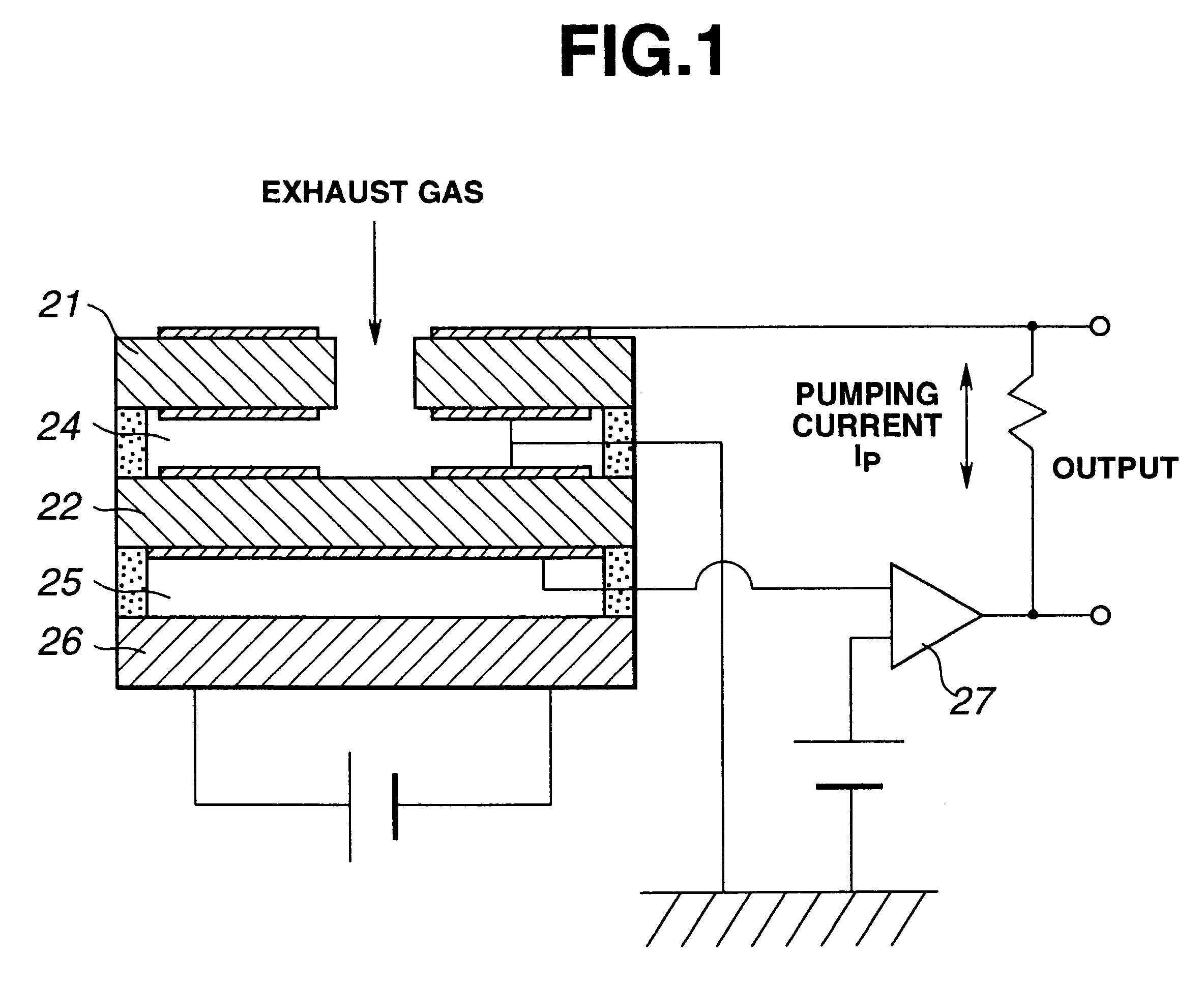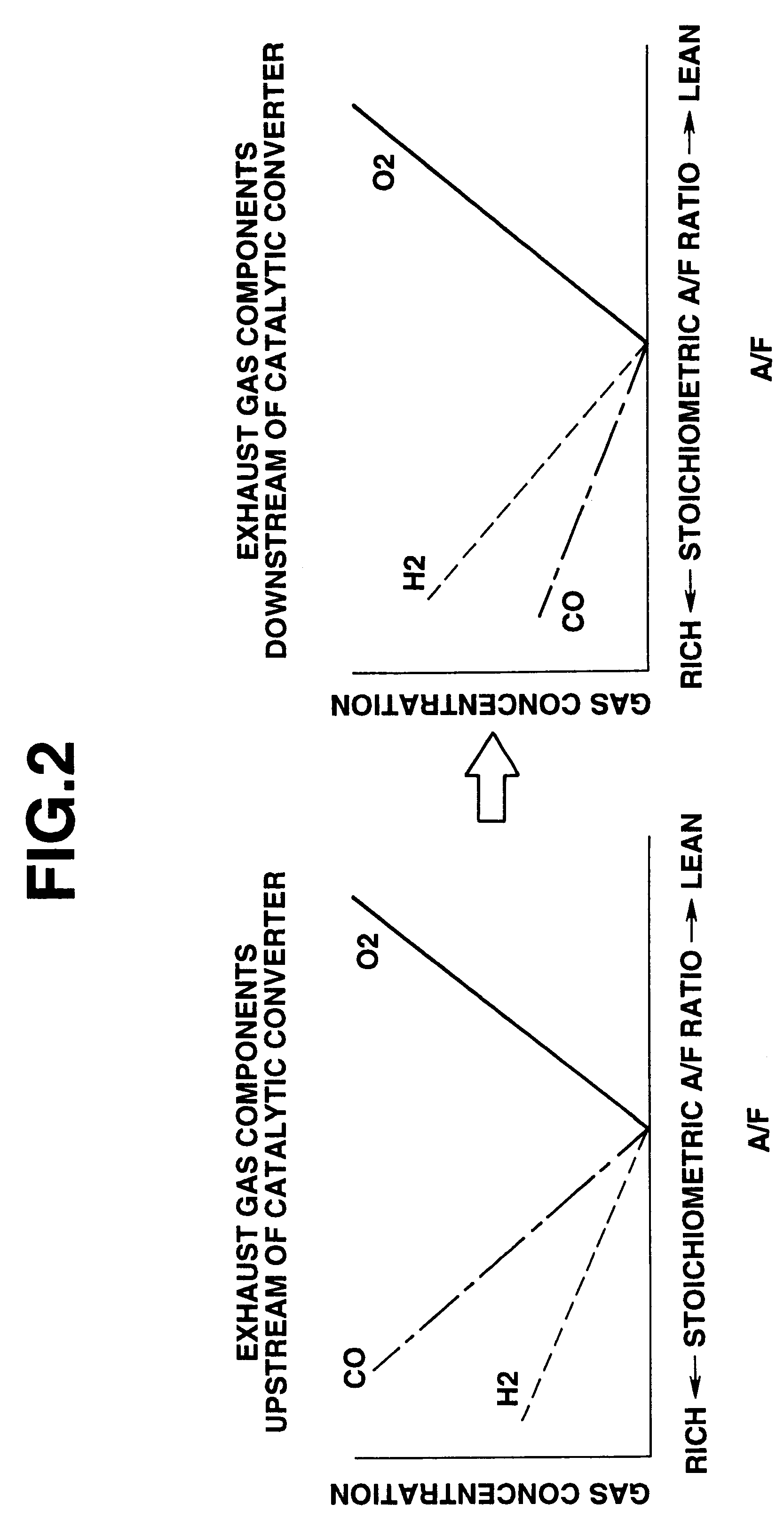Exhaust emission control system for internal combustion engine
a technology for exhaust emission control and internal combustion engines, which is applied in the direction of electric control, machines/engines, instruments, etc., can solve the problems of inability of either side to achieve accurate detection of a/f ratio by the use of the downstream side, and the detection value of the a/f ratio varies,
- Summary
- Abstract
- Description
- Claims
- Application Information
AI Technical Summary
Problems solved by technology
Method used
Image
Examples
first embodiment
Referring first to FIG. 5, an exhaust emission control system according to the present invention includes a catalytic converter 3 having a three-way catalyst and disposed in an exhaust pipe or passage 2 of an internal combustion engine 1. Also disposed in the exhaust passage 2 at locations upstream and downstream of the catalytic converter 3 are a first A / F ratio sensor 4 and a second A / F ratio sensor 5 for detecting the A / F ratio, respectively. The both A / F ratio sensors 4 and 5 are the aforementioned wide-range A / F ratio sensors and are adapted to detect the A / F ratios which are represented by pumping current. The detection signals of the A / F ratio sensors 4 and 5 are inputted to an engine control unit (ECU) 6. To an intake pipe or passage 7 of the internal combustion engine 1 is attached a fuel injector 8 which is adapted to inject fuel in response to an injection signal from the ECU 6. Though the fuel injection quantity is basically controlled in accordance with an operating con...
second embodiment
FIG. 20 shows a second embodiment in which a catalyst temperature sensor 9 is provided to the catalytic converter 3 for detecting the catalyst temperature. FIG. 9 shows a flowchart for obtaining the catalyst deterioration degree R on the basis of the history of catalyst temperature which is obtained by the catalyst temperature sensor 9 provided as above. By the catalyst temperature sensor 9, the catalyst temperature Tc is detected directly (step S20). Then, the catalyst deterioration degree Ra corresponding to the catalyst temperature Tc is obtained by using a map (step S21). The catalyst deterioration degrees Ra are added up in sequence to obtain the age-based catalyst deterioration degree R (step S22) and stored in the memory (step S23). In the meantime, in case the catalyst deterioration sensor 9 is provided in this manner, the above described basic hydrogen correction quantity Sa can be determined on the basis of the catalyst temperature Tc.
third embodiment
FIG. 21 shows a third embodiment in which a hydrogen sensor 10 which is directly reactive to a hydrogen concentration is used for measuring the degree of water gas reaction. The hydrogen sensor 10 includes, for example, a catalytic layer selectively reactive to hydrogen and a catalytic layer not reactive to hydrogen and is operative to detect the hydrogen concentration on the basis of the difference in temperature between the two layers.
The flowchart in FIG. 10 shows a subroutine of the step S5 for the third embodiment, which will be described hereinlater. At step S24, the pumping current Ipb of the second A / F ratio sensor 5 is read. At step S25, it is judged on the basis of the pumping current Ipb whether the A / F ratio is rich, i.e., the pumping current is negative or not. As described above, in case the A / F ratio is lean, there is scarcely an influence of water gas reaction to the pumping current Ipb. Thus, no correction is made to the pumping current Ipb, and the program proceeds...
PUM
| Property | Measurement | Unit |
|---|---|---|
| temperature | aaaaa | aaaaa |
| catalytic temperature | aaaaa | aaaaa |
| concentration | aaaaa | aaaaa |
Abstract
Description
Claims
Application Information
 Login to View More
Login to View More - R&D
- Intellectual Property
- Life Sciences
- Materials
- Tech Scout
- Unparalleled Data Quality
- Higher Quality Content
- 60% Fewer Hallucinations
Browse by: Latest US Patents, China's latest patents, Technical Efficacy Thesaurus, Application Domain, Technology Topic, Popular Technical Reports.
© 2025 PatSnap. All rights reserved.Legal|Privacy policy|Modern Slavery Act Transparency Statement|Sitemap|About US| Contact US: help@patsnap.com



